Privately-Owned Convention Center Parking Garage In Questionable Condition
Our publicly-owned convention center, known as America’s Center, surrounds the privately-owned parking garage at 701 N. 7th Street. The garage, built in 1964, is attached to the former Stix, Baer and Fuller/Dillard’s department store building — now a mixed-use building. The pedestrian bridge over 7th St still exists, but is closed.
The garage was more than a decade old when the Cervantes Convention Center was built across Convention Plaza, previously Delmar. In the early 90s Cervantes was expanded South to Washington Ave and the dome was built to the East. That’s when the garage became surrounded on the North, West, and South. Convention guests can park in the garage and go directly into the convention center.
I photographed from the garage in August 2010, and again last week. During my recent visit I noticed damage I didn’t see nearly 6 years earlier.
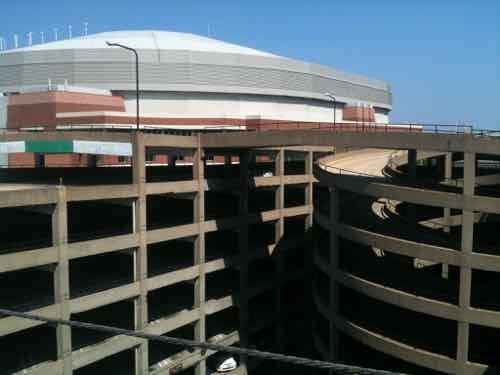
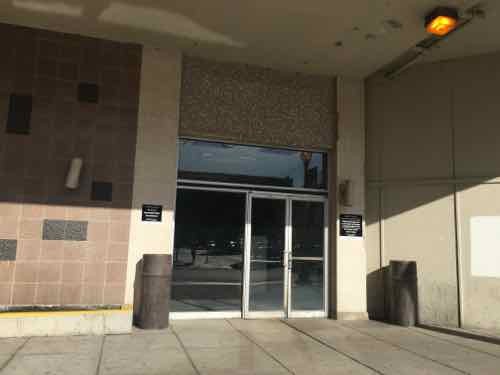
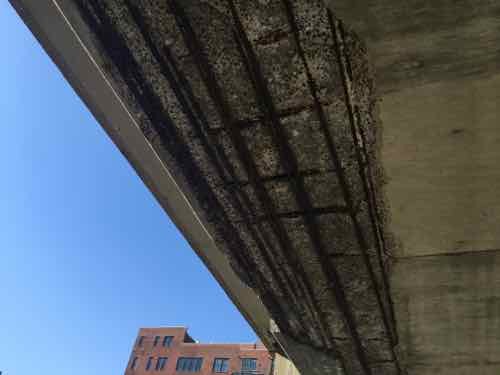
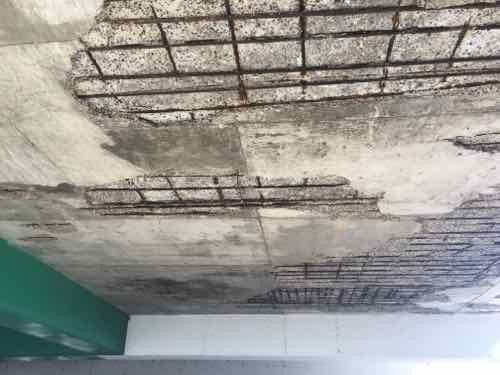
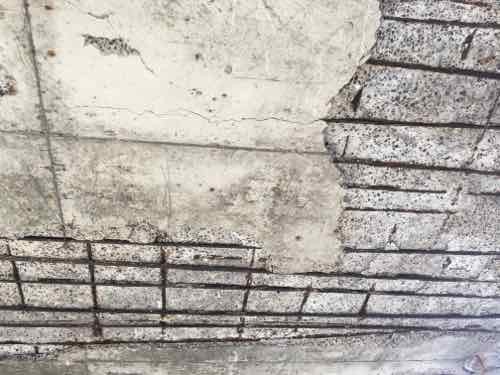
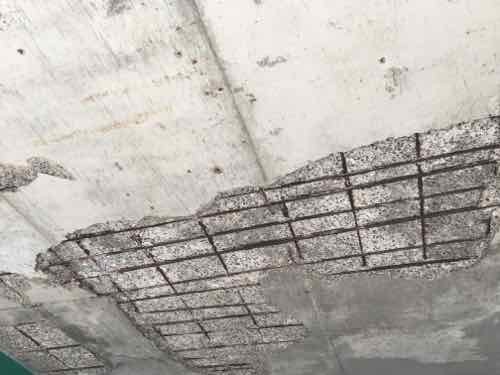
I’m not not qualified to evaluate the damage or integrity of the structure, so I emailed the last four images to reader Mark-AL, an engineer who specializes in parking garages. From his reply:
It’s a garage restoration contractor’s pot of gold! It’s a classic case of garage neglect, where the operator has failed to protect the decks with a sealer or coating and has allowed water to infiltrate the deck, rusting the rebar mats and (probably) the post tensioned cables. The rust on the bottom mat steel has resulted in spalling concrete and general degradation, resulting in loss of deck strength and homogeneity. The upper level of rebar mat is most likely in equal or worse condition, and only god knows how the post tensioned cables are holding up, even though they are likely plastic encased. If the concrete deterioration is widespread and into the PT cable anchorage zones, it is probable that the decks lack the elasticity and plasticity required of the original design, resulting in increasing frictional losses–all of which says that the decks are no longer ready for prime time!
What we don’t know is if the operator is responsible for maintenance, the current operator might not have had the contract very long — we just don’t know. We do know from the lawsuits, regarding the garage at Tucker & Locust, that an operator can only do so much for a structure at the end of it’s useful life. That condemned garage is three years younger than the convention center garage on 7th.
City records show only one inspection — on July 2, 2008. The four violations were complied on June 23, 2010. This morning I’ll be emailing this post to officials at city hall (including the building inspector), Kitty Ratcliffe at the Convention & Visitors Bureau, and the current operator, SP+. They can be the ones to determine if the garage is safe to use.
— Steve Patterson
It depends on what the lease says when it comes to maintenance, but an owner, not a tenant, is usually responsible for maintaining the basic structural integrity of a building. A tenant can assume responsibility (or not) for everything else, from cleaning to mechanical systems to taxes – it all boils down to what is agreed to in the lease. And in the commercial world, a “triple net” lease is fairly common: http://www.propertymetrics.com/blog/2015/02/19/nnn-triple-net-lease/
Interesting perspective from MarkAL. I didn’t realize the decks needed to be coated, does it mean the drainage isn’t adequate also? Is the rebar too low? it looks like maybe only an inch separates the bottom of the concrete from the rebar. These look to be interior shots which is all the more puzzling to me because unless water is running through the interior garage sections should stay dry I would think.
I know Bernard Maybeck designed some buildings across the river at Principia College with concrete roofs, I wonder how they work and if they have to be coated on a regular basis. (around 1930-39 they were built, he used concrete in interiors also, all kinds of places actually)
I remember asking a friend who is a horticulturist and nurseryman if there where any plants that needed virtually no maintenance and he responded that hell, even concrete needs maintenance.
You’re right! Even concrete needs maintenance. The issue with the 1″ soffit coverage that you questioned is typically not an issue to be concerned about. But any less than 1″ is not ideal–but it happens. Plastic chairs (supports) are placed on the wood soffit form before the lower rebar mat is placed. Those chairs are typically 1″ high, and ideally these chairs should elevate the rebar mat approximately 1″ above the bottom of the deck. Often, though, the ironworkers bend/bow/warp the mat and push it down closer to the bottom of the deck when they walk on the bottom mat while they are placing the PT cables and the top mat of rebar. And when the actual concrete is placed, the lower mat may be pushed even closer to the bottom of the concrete deck, due to the activities of the ironworkers, laborers and finishers who engage in the pour. There is really no way to avoid this scenario. Efforts are used to use steel hooks to hook onto the mats during the pour, in an effort to pull up the mats, but you can imagine the degree of difficulty associated with that task, given the thickness of the deck and the dense placement of the steel. PT deck construction shouldn’t be confused with building clocks. It just can’t be that precise. So engineers “over-design” the deck to compensate for these logistical issues faced during placement.
Corrosion in the decks results from water infiltration that absorbs into and from the concrete wearing surface and wicks into the depth of the deck. This happens primarily when cars are driven into the garage during the winter season and drip salt and salt-contaminated water (from the snow-melt used on the streets) onto the deck. When that happens, the salts attack the rebar and PT cables and degrade the concrete. Epoxy coated rebar is typically used to counter the steel corrosion, but it isn’t foolproof. Sustained exposure to even clean water also degrades the concrete, which is why garage operators are cautioned to wash down the decks at least twice a year to remove buildup that naturally collects on the deck. Moisture in the air and water dripping from cars combines with dirt and other contaminants typically found in a garages, and the wet buildup wicks into the decks and degrades the concrete, and the moisture from the degraded concrete then transfers to the the rebar and corrodes it even in non-freezing temps .
When the lower mat of steel rusts, the steel expands. The expanded/rusted steel then pops the concrete soffit, resulting in concrete spalling and general degradation of the deck. This is obvious in Steve’s photos. When this happens, the deck loses its strength and, if widespread, its structural integrity.
And none of this has to happen! The truth is that if either a polyurethane, epoxy or acrylic deck coating is applied every 7-10 years to the wearing surface of the deck, along with other routine maintenance efforts, and if the decks are washed down at least twice a year……………………………..the decks will perform for well over 50 years, depending on the location of the garage. I recently walked through a mildly-reinforced (non-PT) garage that was built in 1939, and its condition is well above average. But it’s clean and it receives regular attention.
The photos in Steve’s posts do not show the worst deck conditions I have seen. I’ve been in garages where I can stand on the top level of the garage and look down and see cars parked on the next lower parking deck! They’re that bad! The garage in today’s blog is certainly salvageable. No question about it, based on the photos I’ve seen. But in its current condition, it needs and deserves attention to prevent further deterioration. A team of qualified technicians can perform “chain drag” tests to determine which areas of the decks need to be cut out and replaced. It’s a simple operation of dragging chains around the garage to expose the “hollow” areas, marking those areas, then turning the results of the tests over to an experienced restoration team to do their thing. My business isn’t rocket science! St Louis has some of the very finest garage restoration contractors in the country. Steve’s garage will be in good hands if one of them is hired….but it’s going to take several big bags of quarters to get it done. Pay now or pay later, bigtime!
Probably the best link I’ve come across that explains post tensioning is this:
https://www.google.com/url?sa=t&rct=j&q=&esrc=s&source=web&cd=1&cad=rja&uact=8&ved=0ahUKEwjKteeUyOfMAhVIQCYKHWdoAXsQFggdMAA&url=http%3A%2F%2Fwww.vsl.net%2Fsites%2Fdefault%2Ffiles%2Fvsl%2Fdatasheet%2FPT_Slabs.pdf&usg=AFQjCNGZS-ABcvCljC6oAPErgqO9khhWQg&sig2=CYTnnrTI8F1nP6yIiVYhAw
It’s easy to follow and, once you’ve read and studied it a bit, you can have my job, with my best wishes….and I can get back to my goat farm!
I don’t blame you about the goat farm, I’m a bit of a dirt farmer myself, having raised pigs, chickens and mostly vegetables. I still have a large garden in my back yard here in the city. The country has a nice quiet pace. Although as you know unless it is a hobby farm you work your ass off, and even on a hobby farm you can. As one farmer said in a recent Feast Magazine “if you can’t find something to do you’re not looking hard enough”. Love it,great quote. Baetje farm is a goat farm that sells their cheese at Soulard Market, they have a website.
I didn’t even think about the salt and its impacts on the garage. I’m always curious about water issues, especially with buildings, but agriculture too.
The post tensioning is interesting, although they say at the beginning. Post tensioning has “Good crack behaviour and therefore permanent protection of the steel against corrosion”, I guess they forgot something.
It looks to be a good overview though, interesting to see how they use anchorage on site to stress the cable. They say each one is recorded, I guess you would oversee that part. They seem to suggest primarily on site tensioning is used.
Sounds like fun. concrete is so fluid, the hard part is building the forms.
I recorded tendon elongations during the first 3 months after grad school. Usually that task is performed by an on-site technician, similar to the personnel used to test the concrete pours, but in the firm I work for, everyone gets experience with every phase of PT work. The cracks the manual refers to are the shrinkage/spider cracks that show up during the first 48-56 hours of cure–in any concrete pour. After 72 hours, if the concrete in a PT deck reaches its interim prescribed strength, the tendons are pulled and, in the process, the spider cracks close up. But those closed cracks offer no protection to the steel against moisture. The concrete is permeable, with or without the spider cracks. The only way to stress a PT cable in poured-in-place concrete is “on-site”–as opposed to pre-stressed cables which occur mostly in precast slabs.
When I lived in St Louis County, I raised Anglo-Nubian goats (the breed my father raises), because their milk has high-average butter fat, and the breed produces milk all year long. Great for cheese makers. Plus, the breed, known for having long pendulous ears, is fun to shepherd in that they are always playful and become very dependent on their keepers and, if you don’t watch out, very amorous–both the billies and the nannies.
Yes, you work your ass off on a farm. You begin at 5 and end at 7 or 8, unless there’s an animal emergency. Then you end up sleeping in the barn. But it’s rewarding work, and at the end of the day, I feel a sense of accomplishment that doesn’t exist for me in my profession.
Oh, and I forgot to respond to your comment about plants and maintenance. There is a plant that grows in the South. It’s called a “Century Plant.” Once it is planted and becomes established, it requires no water, fertilizer or anything else. Long, sharp poisonous thorns develop on the plant, so there are no known natural predators. Locals say these plants grow 100 years (hence the name), then they send up a fibrous stalk about 20′ tall, then a flower develops and blooms 20′ in the air, lasts around 3 weeks……and then the plant dies. A sad but flamboyant curtain call! You should visit God’s country some day….and you’ll see them growing all over the place.
Rainwater is a minor issue; a major issue is in the winter, when cars come in wearing a coating of salty slush, which then melts into a salty brine, that then finds its way into ANY minor cracks in the concrete deck (and, yes, all concrete cracks, as it dries and hardens), attacking any steel it can find . . .
The concrete roofs at Principia are likely covered with either a membrane roofing material (fully adhered) or some type of polyurethane sealant– to protect the reinforcing steel in the roof deck. Concrete is permeable. Water penetrates it. Without an exterior top-coating and some type of thermal control (insulation) , water and condensation will drip onto the ceiling on the top level. There are only two promises you can make about concrete: it will get hard…and it will crack.
It has been awhile since I have been up to Principia, I think there are both monolithic concrete and concrete roof tiles for roofs. Thermal control is necessary for all roofs so that part isn’t a surprise. I don’t know maybe the slopes of the roofs have an impact, I just wouldn’t think they want to install a roof they had to coat every 7 to 10 years. I know marble sculptures are slowly introduced to the outside to build up a surface to resist degradation.
By the way Principia is on a bluff overlooking the Mississippi between Alton and Grafton. Its a great day trip, a little past Grafton is the Brussels Ferry, you cross the Illinois River to the land that is part of where the Illinois meets the Mississippi, from there you can head to Golden Eagle Ferry. There is a restaurant you can sit in a watch the activity on the river, actually the restaurant has a dock.
Any you take the Golden Eagle to St Charles County and pretty well circle around for a nice day trip.
Principia’s roof would NOT have to be coated every 7 to 10 years. Traffic on a roof deck is far different from traffic on a parking deck. A simple rubber membrane or even a traditional built-up roof would work well for Principia’s roof decks.
The highrise apartment building in Milwaukee I lived at from 2006 – 2008 was built in 1964 with a large underground parking garage. As the building was built on the edge of a bluff, the rear of the parking garage was visible on the bike trail below the bluff and showed horrendous rebar corrosion with associated deteriorated concrete. It wouldn’t have been something I would have allowed as building owner, but the company that owned the building (the same one that had built it decades before) was notably stingy in addressing building maintenance issues and allowed this and various other expensive problems to accumulate for the new owner they sold the building to in 2007. I’ve not been back for some years but would be surprised if the problem has still not been addressed.